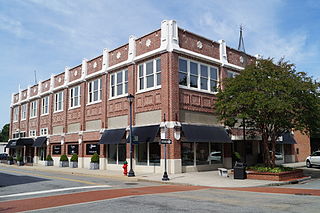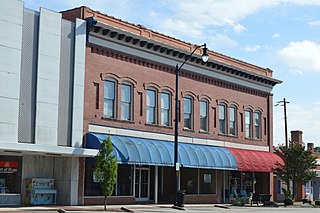
Green Level is an unincorporated community near the town of Cary in southwestern Wake County, North Carolina, United States. It was founded around 1800, and is one of the oldest surviving crossroads communities in the Raleigh area.

Downtown Asheville Historic District is a national historic district located at Asheville, Buncombe County, North Carolina. The district encompasses about 279 contributing buildings and one contributing object in the central business district of Asheville. It includes commercial, institutional, and residential buildings in a variety of popular architectural styles including Colonial Revival, Queen Anne, and Art Deco.

Morganton Downtown Historic District is a national historic district located at Morganton, Burke County, North Carolina. It encompasses 62 contributing buildings in the central business district of Morganton. It includes commercial, industrial, and governmental buildings built between about 1889 and 1940. It includes representative examples of Classical Revival, Art Deco, and Italianate style architecture. Notable buildings include the Old Burke County Courthouse, Morganton Post Office, and the Morganton Community House.

Lenoir Downtown Historic District is a national historic district located at Lenoir, Caldwell County, North Carolina. The district includes 41 contributing buildings and 2 contributing objects in the central business district of Lenoir. It includes commercial, governmental, and institutional buildings in a variety of popular architectural styles including Art Deco, Art Moderne, Classical Revival and Tudor Revival. Notable contributing resources include the Center Theater (1941), O. P. Lutz Furniture Company and Lutz Hosiery Mill (1939), Dayvault's Drug Store (1937), Caldwell County Agricultural Building (1937), Courtney Warehouse, Masonic Hall, Miller Building, Confederate Monument (1910), Belk's Department Store (1928), Lenoir Building (1907), J. C. Penney Department Store, Fidelity Building (1928), and U. S. Post Office (1931). Located in the district is the separately listed Caldwell County Courthouse.

Uptown Lexington Historic District is a national historic district located at Lexington, Davidson County, North Carolina. The district encompasses 52 contributing buildings, 3 contributing sites, and 1 contributing object in the central business district of Lexington. It includes commercial and governmental buildings built between 1824 and 1946. Located in the district is the separately listed Old Davidson County Courthouse. Other notable buildings include the former United States Post Office (1911-1912), Raper Building, Moffitt Building (1920s), Smith-Thompson Block (1900), the Development Building, the Buchanan-Siceloff Building (1923-1929), the Hinkle Block (1902-1907), the Hankins Building (1902), Hedrick's Hall (1902), and the Earnhardt Building (1923-1929).

Downtown Gastonia Historic District is a national historic district located at Gastonia, Gaston County, North Carolina. It encompasses 77 contributing buildings and 1 contributing object in the central business district of Gastonia. The commercial, civic, institutional, and multi-unit residential buildings were built between the 1890s and 1954, and include notable examples of Colonial Revival and Classical Revival architecture. Located in the district are the separately listed former Gaston County Courthouse, First National Bank Building, Third National Bank Building, and Robinson-Gardner Building. Other notable buildings include the U.S. Post Office (1935), York Medical Building (1938), Kress Department Store, Leibowitz Department Store, Ideal Moving Picture Theater, City Hall, Kirby Building (1922), First Baptist Church (1922), Gaston County War Memorial Hall (1928), and the (former) Gaston County Public Library (1930).

Oxford Historic District is a national historic district located at Oxford, Granville County, North Carolina. The district encompasses 201 contributing buildings, 1 contributing site, and 2 contributing objects in the central business district and surrounding residential sections of Oxford. It includes buildings dating from the early-19th century through the 1930s and notable examples of Greek Revival and Late Victorian style architecture. Located in the district is the separately listed Granville County Courthouse (1838-1840). Other notable buildings include the Bryant-Kingsbury House, Taylor-McClanahan-Smith House (1820s), former Granville County Jail, Oxford Women's Club, Titus Grandy House (1850s), Oxford Presbyterian Church, St. John's College, Lyon-Winston Building (1911), Herndon Block Number 2, Hunt Building, L. H. Currin-American Tobacco Company (1860s), and St. Stephens Episcopal Church (1902).

Williamston Commercial Historic District is a national historic district located at Williamston, Martin County, North Carolina. The district encompasses 31 contributing buildings in the central business district of Williamston. They include notable examples of Greek Revival, Colonial Revival, and Romanesque architecture in buildings dated from the mid-19th century through the 1920s. Located in the district is the separately listed Martin County Courthouse. Other notable buildings include the Docton W. Bagley Building, (former) People's Bank (1917), Watts Theatre, the Tar Heel Apartments (1921), the Flatiron Building, and the United States Post Office (1938). The post office contains a mural, First Flight of the Wright Brothers at Kitty Hawk, by Philip von Saltza, painted in 1940 as part of the Works Project Administration's mural project.

Northside Historic District is a national historic district located at Elizabeth City, Pasquotank County, North Carolina. The district encompasses 398 contributing buildings in a predominantly residential section of Elizabeth City. The district developed from the mid-19th to mid-20th century, and includes representative examples of Greek Revival, Queen Anne, Colonial Revival, Bungalow / American Craftsman, and Classical Revival style architecture. Notable contributing buildings include the John S. Burgess House, Scott-Culpepper House, Luther C. Lassiter House (1908-1913), William F. Williams House (1908-1914), Miles Pritchard House, Mack N. Sawyer House (1895), the Godfrey-Foreman House, Dr. Walter W. Sawyer House (1915), City Road United Methodist Church (1900-1902), Blackwell Memorial Baptist Church (1902), former Elizabeth City High School (1923), and S. L. Sheep School (1940).

Dickinson Avenue Historic District is a national historic district located at Greenville, Pitt County, North Carolina. The district encompasses 35 contributing buildings and 3 contributing structures in a mixed commercial and industrial section of Greenville. It includes buildings dated from about 1902 to 1956 and notable examples of Classical Revival and Commercial architecture. Notable buildings include the Brown Building, Hines Building, First Christian Church (1916), Roxy Theater (1948), and the Imperial Tobacco Company factory (1902-1964).

Greenville Commercial Historic District is a national historic district located at Greenville, Pitt County, North Carolina. The district encompasses 51 contributing buildings in the central business district of Greenville. It includes buildings dated from about 1914 to 1952 and notable examples of Greek Revival and Queen Anne style architecture. Located in the district and listed separately are the Pitt County Courthouse (1911) by Milburn, Heister & Company and U.S. Post Office (1913). Other notable buildings include the Proctor Hotel (1911), Montgomery Ward Department Store (1929), Dail-Hodges Building (1919), Blount Building (1924), Greenville Bank and Trust, Smith Electric Building, Greenville Municipal Building (1929) designed by Benton & Benton, Blount-Harvey Department Store (1923), White's Theater (1914), Charles Greene House (1860), and the Robert Lee Humber House (1895).

Main Street Commercial Historic District is a national historic district located at Hamlet, Richmond County, North Carolina. The district encompasses 23 contributing buildings, 3 contributing structures, and 1 contributing object in the central business district of Hamlet. It includes buildings built between about 1900 to about 1940 and notable examples of Queen Anne, Art Deco, and Classical Revival architecture. Located in the district is the separately listed Seaboard Air Line Passenger Depot. Other notable buildings include the Terminal Hotel, Union Building, the Bank of Hamlet (1912), the Old Hamlet Opera House, and the U.S. Post Office (1940), a Works Progress Administration project.

Lumberton Commercial Historic District is a national historic district located at Lumberton, Robeson County, North Carolina. The district encompasses 64 contributing buildings and 1 contributing site in the central business district of Lumberton. It includes buildings built between about 1840 to 1941 in a variety of popular architectural styles including Classical Revival and Streamline Moderne. Located in the district are the separately listed Carolina Theatre and Planters Building. Other notable buildings include the Proctor Law Office, McLeod Building (1879), (former) National Hotel, (former) Efird's Department Store, Huggins Star Shoe Shop, National Bank of Lumberton (1914), Dresden Cotton Mills Office Building, (former) Lumberton Municipal Building (1917), and Stephens Funeral Home (1936).

Salisbury Railroad Corridor Historic District is a national historic district located at Salisbury, Rowan County, North Carolina. The district encompasses 37 contributing buildings and 1 contributing site consisting primarily of railroad-related and commercial buildings. It largely developed during the first half of the 20th century, and includes notable examples of Mission Revival style architecture. Located in the district is the separately listed Salisbury Southern Railroad Passenger Depot designed by Frank Pierce Milburn. Other notable buildings include the Cheerwine/Carolina Beverage Corporation Building (1913), Yadkin Hotel (1913), Frick Building, Boyden-Overman Company Cotton Warehouse, and Old Freight Depot.

Main Street Historic District is a national historic district located at Forest City, Rutherford County, North Carolina. It encompasses 61 contributing buildings, 1 contributing site, and 1 contributing structure in the central business district of Forest City. The district developed from the late 1880s through the 1920s, and includes notable examples of Classical Revival style architecture. Notable contributing buildings include the U.S. Post Office (1937), the Davis Sisters Building, the Farmers Bank and Trust building (1923), National Bank of Forest City (1923), the Tuberculosis Center (1902), the Romina Theater (1928), the Town Hall (1928) designed by James J. Baldwin, the Blanton Hotel (1925), the Reinhardt Drug Company Building, the First Wesleyan Church (1922), and the Florence Mill (1897-1941).

Main Street Historic District is a national historic district located at Rutherfordton, Rutherford County, North Carolina. It encompasses 43 contributing buildings and 1 contributing object in the central business district of Rutherfordton. The district developed from about 1898 to 1945, and includes notable examples of Classical Revival and Colonial Revival style architecture. Located in the district is the separately listed Rutherford County Courthouse designed by Louis H. Asbury (1877-1975). Other notable contributing buildings include the U.S. Post Office (1931), the Norris Public Library (1933), (former) Rutherford County Jail, Commercial National Bank, Keeter Hardware Company Building, Geer Commercial Building, Southern Hotel Company Building, Geer-Warlick Motor Company Building, and City Hall (1925) designed by Milburn, Heister & Company.

College Street Historic District is a national historic district located at Clinton, Sampson County, North Carolina. The district encompasses 22 contributing buildings in a predominantly residential section of Clinton. It developed between about 1840 to the 1930s, and includes notable examples of Greek Revival, Colonial Revival, and Classical Revival architecture. Located in the district is the separately listed Graves-Stewart House. Other notable buildings include the Colonel John Ashford House, College Street Elementary School (1911), John R. Beaman House (1850s), Hobbs-Matthews-Small House, Dr. Fleet Rose Cooper House (1890s), Jim McArthur House (1905-1910), Kate Powell House, Henry L. Stewart House (1926), Dr. R. A. Turlington House, Carroll-Morris House, and Turlington Rental House (1929).

West Main–North Chesnutt Streets Historic District is a national historic district located at Clinton, Sampson County, North Carolina. The district encompasses 44 contributing buildings in a predominantly residential section of Clinton. It developed between about 1830 to the early 1930s, and includes notable examples of Greek Revival, Colonial Revival, and Gothic Revival architecture. Notable buildings include the Richard Clinton Holmes House, Amma. F. Johnson House (1868), Dr. William G. Micks House (1851), William Hubbard House, R. H. Hubbard, Sr. House, St. Paul's Episcopal Church (1902), L. C. Graves Presbyterian Church (1908), C. B. Barrus House (1923), the Hathcock-Hobbs House, the Gabe Barbrey House (1932), and the F. L. Turlington House (1937).

Bethune-Powell Buildings are two historic commercial buildings located at Clinton, Sampson County, North Carolina. They were built in 1902, and are two-story, brick buildings with decorative pressed metal sheathing and brick cornices on the front facade. The Bethune Building is six bays wide and the Powell Building three bays wide. The pressed metal sheathing features a robust pattern of colonnaded, arched garland friezes, and modillion cornice. The buildings were constructed following a fire that destroyed much of the Clinton commercial district.

Johnson Building is a historic commercial building located at Clinton, Sampson County, North Carolina. It was built about 1902, and is two-story, five bay by eight bay, brick building with Classical Revival-style details. The front facade features arched windows, brick corner pilasters, recessed brick panels, decorative metal cornice, and a raised parapet. The building was constructed following a fire that destroyed much of the Clinton commercial district.






















